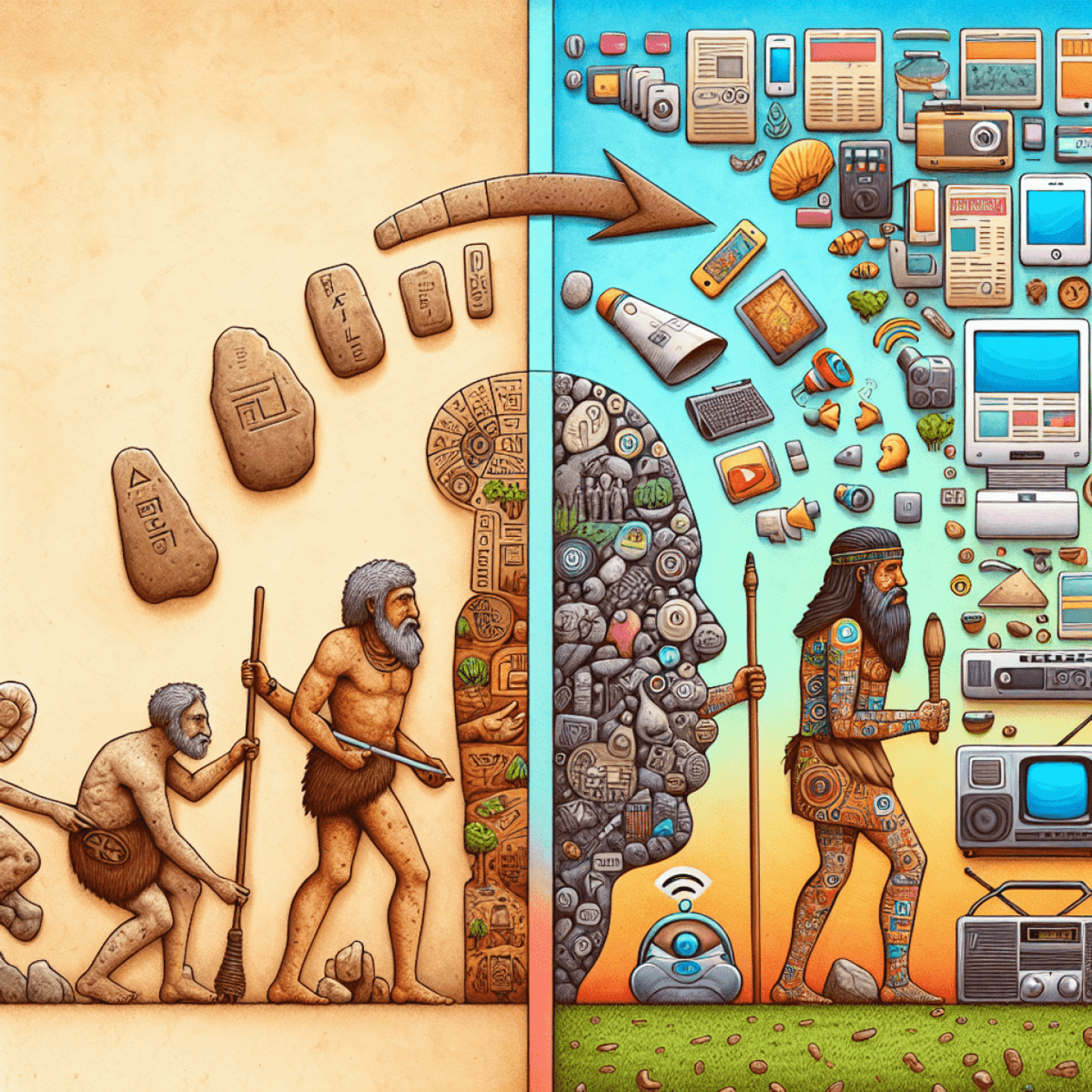
Our spy tools monitor millions of native ads from over 60+ countries and thousands of publishers.
Get StartedNative advertising, a marketing strategy that seamlessly integrates promotional content into non-promotional contexts, has been an essential part of our lives for far longer than you may realize. Its evolution can be traced back to ancient civilizations using storytelling and entertainment as crude forms of advertising, slowly morphing into the sophisticated digital strategies we witness today.
The shift from print to digital has significantly shaped native advertising, transforming it from advertorials in newspapers and magazines to sponsored posts on social media platforms. Today, native advertising accounts for 60% of the market share, becoming a substantial revenue stream for the modern publishing industry. It's become such an integral part of content creation that news publishers are now hiring staff specifically for ad creation, blurring the lines between journalism and advertising.
The relevance of native advertising in the modern era is undeniable. In an age where audiences have become adept at tuning out intrusive banner ads and pop-ups, native ads provide a more subtle approach that respects user experience while still promoting a brand or product.
However, with its increasing popularity come potential ethical concerns. Conflicts of interest between newsrooms and advertisers could arise as they navigate this fine line between informative content and promotional material. This is why it's crucial to maintain transparency and adhere to best practices when implementing native advertising strategies.
In this guide, we'll explore:
Whether you're a marketer seeking new ways to reach your audience or simply a curious reader wanting to understand the world of digital advertising better, this guide will provide valuable insights into the world of native advertising.
If you're interested in building winning native advertising campaigns today by spying on your competition & getting more value for your advertising spend, platforms like Anstrex Native can be a valuable resource.
The evolution of native advertising can be traced back to ancient civilizations where early forms of advertising existed. At that time, the focus was on telling stories and providing entertainment to engage customers - the earliest versions of native advertising.
As societies progressed and print media became a powerful communication tool, native advertising also evolved.
In the world of newspapers, native advertising took on various forms:
The underlying principle behind these native advertising strategies during the print era was simple: make ads blend in naturally with the content. By doing so, advertisers aimed to create an environment where advertisements felt less intrusive and more like a valuable part of what readers were consuming.
This approach continues to influence native advertising practices today, although with updated methods tailored for the digital landscape.
The rise of digital media brought significant changes to native advertising. In the past, native ads relied on storytelling and entertainment, but with the advent of digital platforms, more advanced techniques took over.
Moving from print media to digital platforms opened up new possibilities and challenges for advertisers:
Social media platforms played a crucial role in transforming native advertising:
Digital publishing brought about a significant change in how ads were managed:
Digital publishing also introduced a new level of precision targeting:
With the rise of digital publishing, native advertising underwent a significant transformation:
While digital publishing brought numerous benefits to advertisers, it also posed some challenges:
As native advertising has evolved, new technologies and platforms have emerged to facilitate its growth. One significant advancement in this field is the introduction of programmatic technology in native advertising. This modern approach leverages algorithms and data to automate the buying, placement, and optimization of media inventory. By doing so, it replaces traditional methods that involved human negotiation and manual insertion orders.
Programmatic technology paves the way for a more efficient and precise ad targeting process. For instance, advertisers can utilize real-time bidding (RTB) to buy ad impressions on an individual basis. This not only allows advertisers to reach the right audience at the right time but also ensures they pay the most optimal price for each ad impression.
Another notable development is the use of content recommendation widgets for native ads. These widgets are typically placed at the bottom of webpages and suggest related content or products based on user behavior and browsing history. Prominent examples include Outbrain and Taboola which are commonly seen across various news websites and digital publications.
Content recommendation widgets serve two primary purposes:
These tools have transformed native advertising from a simple advertorial model into a dynamic, data-driven strategy that delivers personalized experiences to consumers. Despite these advancements, it's important for marketers to remember that successful native advertising should be about providing value through high-quality content, rather than just achieving high click-through rates.
In this digital age where personalization is paramount, these new technologies and platforms certainly mark a significant milestone in the evolution of native advertising. However, as we look towards the future, one thing remains constant: the need for authenticity and transparency in all forms of advertising strategies.
The digital era has brought a plethora of different types of native advertising. Each type serves a unique purpose and offers specific advantages when applied strategically.
These are organic ads that seamlessly blend with the platform's content. An example would be sponsored posts on Facebook or promoted tweets on Twitter.
These ads appear at the top of search engine results or within product listings, resembling regular search results or listings. Google's AdWords is a prime example.
These are typically found at the end of articles as suggested reading. Platforms like Outbrain and Taboola specialize in this type of native advertising.
This involves creating content that subtly promotes a brand or product but primarily focuses on engaging the user. A classic example is Red Bull's extreme sports videos that highlight the brand without overtly selling it.
Native advertising advantages are numerous and encompass various aspects of digital marketing strategies:
Embracing these types of native advertising and understanding their advantages can greatly enhance your digital marketing strategy. By delivering engaging content in a non-disruptive manner, you not only respect your audience's online experience but also enhance your brand reach effectively.
Native advertising's seamless integration into content can foster a unique set of ethical concerns. The blending of advertising with editorial content often leads to the core issue: discernibility. Readers may find it challenging to distinguish between what is paid advertising and what is genuine editorial content. This lack of transparency can undermine the trust that audiences have in media outlets.
Advertiser influence on editorial decisions presents a significant ethical dilemma. When advertisers fund content, there is a risk that newsrooms may prioritize commercial interests over journalistic ethics, potentially leading to:
To address these conflicts, it's crucial for publishers to:
By grappling with these ethical challenges head-on, publishers can uphold their duty to provide truthful and unbiased information. As native advertising continues to evolve, so too must the strategies employed by newsrooms and advertisers to maintain trust and integrity in journalism.
The world of native advertising is always changing. As print ads move to the digital realm, the industry is undergoing a major transformation. This shift has opened doors for more refined strategies like influencer marketing and user-generated content, which rely on social proof and authenticity.
Influencer marketing has become an essential part of native advertising. Brands team up with influencers - people who have a large following on social media platforms - to create content that resonates with their audience. This collaboration offers several advantages:
Successful influencer marketing campaigns include those by Daniel Wellington and Glossier, where influencers from various platforms feature products in a way that aligns with their personal stories.
User-generated content (UGC) takes native advertising a step further by involving consumers directly in the creation process. Encouraging users to share their experiences with a product or service results in powerful endorsements that are relatable and trustworthy.
Key aspects of UGC in native advertising include:
Campaigns like Coca-Cola's "Share a Coke" and Starbucks' "#WhiteCupContest" demonstrate the impact UGC can have when incorporated into native advertising strategies.
Advancements in technology have introduced new tools and platforms that enhance the effectiveness of native advertising campaigns. Among these innovations, programmatic technology and content recommendation widgets stand out.
Programmatic technology automates the buying and placing of ads using artificial intelligence. This allows for real-time bidding on ad inventory, ensuring that native ads are displayed to the right audience at the optimal time. Benefits include:
Platforms such as Google's DoubleClick and The Trade Desk exemplify how programmatic technology is being utilized for effective native advertising campaigns (SmartyAds) (Niche Pursuits) (Taboola Blog) (Bullseye Strategy)
Content recommendation widgets are tools used by publishers to suggest additional content to readers. These widgets often include sponsored posts that match the look and feel of organic articles on a website. They help increase visibility for advertisers while providing value to readers through relevant recommendations.
Key advantages of using content recommendation widgets include:
Outbrain and Taboola are notable examples of platforms offering content recommendation widgets suited for native ad placements.
As technologies develop and adapt, so too does native advertising. These innovations not only create opportunities for brands but also challenge them to remain authentic while effectively reaching their target audiences. With each technological advance, user experience remains at the forefront — ensuring that native ads continue to engage consumers without disrupting their online journey.
Balancing the scales in native advertising is crucial. It's important to find a balance that respects both users and publishers, creating a positive environment for effective digital advertising. Respecting users means providing valuable content that they find useful or interesting. This helps to build trust and increase engagement. On the other hand, respecting publishers means understanding their need for revenue to continue producing high-quality content.
The world of digital advertising is always changing, and native advertising is at the forefront of this evolution. That's why it's essential to stay updated with the latest trends and best practices:
In native advertising, being adaptable is key. Being able to navigate through changes requires understanding the fundamental principles while being open to new ideas.
Now let's explore how these principles apply in real-world scenarios by looking at different types of native advertising, their benefits, and some successful examples in the digital age.
Receive top converting landing pages in your inbox every week from us.
How-To
Native ads can do more than drive clicks—they can build long-term brand loyalty. Learn how to use authentic storytelling, strategic placement, and audience targeting to strengthen trust during year-end campaigns. Discover how subtle, value-driven messaging keeps customers engaged beyond the holidays. Ideal for marketers aiming to turn seasonal buyers into loyal brand advocates.
Marcus Chen
7 minDec 15, 2025
Must Read
As third-party cookies fade away, contextual targeting is making a powerful comeback. Learn how to leverage native ads that align with user intent and content relevance to maintain high engagement and conversions. Discover modern tools and tactics that make cookie-free targeting both precise and scalable. Ideal for advertisers seeking privacy-friendly ways to drive performance in 2025 and beyond.
Liam O’Connor
7 minDec 9, 2025
Recently Updated
Native ads can make or break your holiday marketing success. Explore how to evaluate your recent campaigns and identify what worked—or what fell short—with native advertising. Learn key optimization tactics to boost engagement, strengthen audience trust, and increase conversions in future promotions. Ideal for marketers aiming to refine their ad strategies after the holiday rush.
Elena Morales
7 minDec 1, 2025




